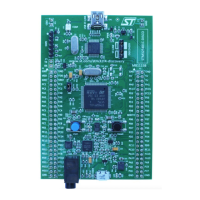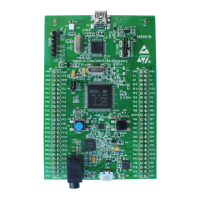RM0402 Rev 6 1005/1163
RM0402 USB on-the-go full-speed (OTG_FS)
1122
Bit 4 RXFFLSH: Rx FIFO flush
The application can flush the entire Rx FIFO using this bit, but must first ensure that the core
is not in the middle of a transaction.
The application must only write to this bit after checking that the core is neither reading from
the Rx FIFO nor writing to the Rx FIFO.
The application must wait until the bit is cleared before performing any other operations. This
bit requires 8 clocks (slowest of PHY or AHB clock) to clear.
Note: Accessible in both device and host modes.
Bit 3 Reserved, must be kept at reset value.
Bit 2 FCRST: Host frame counter reset
The application writes this bit to reset the frame number counter inside the core. When the
frame counter is reset, the subsequent SOF sent out by the core has a frame number of 0.
When application writes '1' to the bit, it might not be able to read back the value as it gets
cleared by the core in a few clock cycles.
Note: Only accessible in host mode.
Bit 1 PSRST: Partial soft reset
Resets the internal state machines but keeps the enumeration info. Could be used to recover
some specific PHY errors.
Note: Accessible in both device and host modes.
Bit 0 CSRST: Core soft reset
Resets the HCLK and PHY clock domains as follows:
Clears the interrupts and all the CSR register bits except for the following bits:
– GATEHCLK bit in OTG_PCGCCTL
– STPPCLK bit in OTG_PCGCCTL
– FSLSPCS bits in OTG_HCFG
– DSPD bit in OTG_DCFG
– SDIS bit in OTG_DCTL
– OTG_GCCFG register
All module state machines (except for the AHB slave unit) are reset to the Idle state, and all
the transmit FIFOs and the receive FIFO are flushed.
Any transactions on the AHB Master are terminated as soon as possible, after completing the
last data phase of an AHB transfer. Any transactions on the USB are terminated immediately.
The application can write to this bit any time it wants to reset the core. This is a self-clearing
bit and the core clears this bit after all the necessary logic is reset in the core, which can take
several clocks, depending on the current state of the core. Once this bit has been cleared,
the software must wait at least 3 PHY clocks before accessing the PHY domain
(synchronization delay). The software must also check that bit 31 in this register is set to 1
(AHB Master is Idle) before starting any operation.
Typically, the software reset is used during software development and also when the user
dynamically changes the PHY selection bits in the above listed USB configuration registers.
When you change the PHY, the corresponding clock for the PHY is selected and used in the
PHY domain. Once a new clock is selected, the PHY domain has to be reset for proper
operation.
Note: Accessible in both device and host modes.

